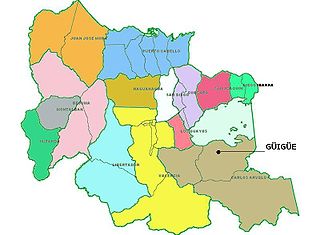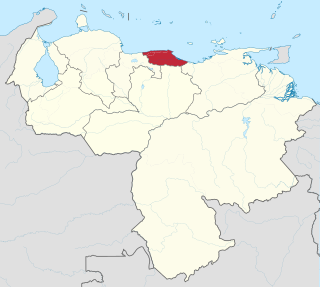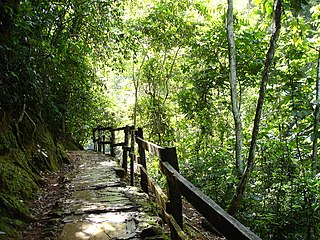
Caracas, officially Santiago de León de Caracas, abbreviated as CCS, is the capital and largest city of Venezuela, and the center of the Metropolitan Region of Caracas. Caracas is located along the Guaire River in the northern part of the country, within the Caracas Valley of the Venezuelan coastal mountain range. The valley is close to the Caribbean Sea, separated from the coast by a steep 2,200-meter-high (7,200 ft) mountain range, Cerro El Ávila; to the south there are more hills and mountains. The Metropolitan Region of Caracas has an estimated population of almost 5 million inhabitants.

Aragua State is one of the 23 states of Venezuela. It is located in the north-central region of Venezuela. It has plains and jungles and Caribbean beaches. The most popular are Cata and Choroni. It has Venezuela's first national park which is called Henri Pittier. The capital is Maracay, other important cities include Turmero and El Limón.

Anzoátegui State is one of the 23 states of Venezuela, located in the northeastern region of the country. Anzoátegui is well known for its beaches that attract many visitors. Its coast consists of a single beach approximately 100 km (62 mi) long. Its capital is the city of Barcelona, and significant cities include Puerto la Cruz and El Tigre.

Miranda State is one of the 23 states of Venezuela and the second most populous after Zulia State. As of the 2011 census, it had a population of 2,675,165 residents. It also has the greatest Human Development Index in Venezuela, according to the Venezuelan National Institute of Statistics. The most recent population estimate was 3,194,390 in mid-2016.

Barcelona originally founded as Nueva Barcelona del Cerro Santo, New Barcelona or also called La Nueva Barcelona, is a city located in the northeast of Venezuela. Founded in 1557 by the Spanish military conquistador of Catalan origin Joan Orpí. It is the capital of the Anzoátegui State. Barcelona has a population of 954,928 inhabitants, according to INE data, (2011)[1] with Puerto La Cruz, Lecheria and Guanta, making up Greater, Gran Barcelona the largest and most important metropolitan area in the Eastern Region from Venezuela, the city preserves a variety of buildings dating from the viceregal era, Venezuela

The Bolivarian Republic of Venezuela is a federation made up of twenty-three states, a Capital District and the Federal Dependencies, which consist of many islands and islets in the Caribbean Sea. Venezuela also claims the Guayana Esequiba territory which comprises six districts in the independent nation of Guyana.

Los TequesSpanish pronunciation: [los ˈtekes]) is the capital of the state of Miranda and the municipality of Guaicaipuro Municipality. It is located in the capital region of north-central Venezuela. More specifically, southwest of Caracas, 10° 21' 00" N latitude and 67° 02' 30" W Greenwich, 1,169 m above sea level. It is located in the Cordillera de la Costa, on the banks of the Río San Pedro, descending from an area located in the northeast. According to the Office for National Statistics in 2016, Los Teques has a population of 252,242 people. The city is considered to be part of the agglomeration known as Greater Caracas.

Municipalities of Venezuela are subdivisions of the States of Venezuela. There are 335 municipalities dividing the 23 states and the Capital District.

Dulce Nombre de Jesus de Petare is a neighborhood in Miranda, Venezuela, and is part of the Metropolitan District of Caracas. It is located in the Sucre Municipality, one of the five divisions of Caracas. The city was founded in 1621 under the name of San Jose de Guanarito. It grew to become a part of the Greater Caracas area as the latter expanded in area and population. Petare had a population of 372,106 inhabitants and about 448,861 according to 2020 estimates. Petare is the biggest slum in Venezuela, and in South America.

The Venezuelan Coastal Range, also known as Venezuelan Caribbean Mountain System is a mountain range system and one of the eight natural regions of Venezuela, that runs along the central and eastern portions of Venezuela's northern coast. The range is a northeastern extension of the Andes, and is also known as the Maritime Andes. It covers around 48,866 km2, being the 4th largest natural region in Venezuela.

Higuerote is the capital city of Brión Municipality, located in the coastal region of Barlovento, in the state of Miranda, Venezuela, approximately an hour and a half from Caracas.

Güigüe is a city in the south of the Valencia Lake, in Carabobo, Venezuela. It is the capital of the Carlos Arvelo Municipality and of the Güigüe parish. The Güigüe River flows through the city, draining in Lake Valencia.
The Tuy River is a river of northern Venezuela, in the Valles del Tuy of Miranda State. The principal river of Miranda, it flows north from Aragua State through Miranda into the Caribbean Sea. Tributaries include the Guaire River, the principal river of Caracas, and the Caucagua River.

Afro-Venezuelans are Venezuelans of African descent. About 4% of the Venezuelan population self-identify as "black" or "Afro-descendant", although most Venezuelans are mixed with African ancestry. Afro-Venezuelans are mostly descendants of enslaved Africans brought to the Western Hemisphere during the Atlantic slave trade. This term also sometimes refers to the combining of African and other cultural elements found in Venezuelan society such as the arts, traditions, music, religion, race, and language.
Chuspa is a village in the Venezuelan state of Vargas. The village is mainly a fishermen's location with some tourist attractions. It is connected through a coast road with La Guaira and Higuerote. The town is located at the side of the Chuspa river.

The Capital Region is one of the nine administrative regions in which Venezuela is divided. It includes the states Miranda and Vargas, as well as the Capital District. In 2011, the population of the region was reported to be more than 5 million people.

Tourism in Venezuela has been developed considerably for decades, particularly because of its geographical position, the variety of landscapes, the richness of plants and wildlife, the artistic expressions and the privileged tropical climate of the country, which affords each region throughout the year. Since 2013 the country is having a very severe economic and political crisis affecting tourism all over the country.

The Guatopo National Park Is a protected area with the status of national park in the north of the South American country of Venezuela. It is located specifically between the states of Miranda and Guárico, bordered on the north by the Cordillera de la Costa and the Barlovento Plain, on the south by the Piedemonte Llanero, on the east it borders on the continuation of the Serranía del Interior and The west with the continuation of the same Serranía and with the Valleys of the Tuy.
The 1900 Venezuelan earthquake, occurred on October 28 at between 4:30 and 4:45 am local time. This earthquake had an epicenter off Miranda State or near the Venezuelan capital Caracas, in the Cariaco Basin. It had an estimated moment magnitude of 7.6–7.7 and a surface-wave magnitude of 7.7–8.4. It had a maximum Mercalli intensity assigned VIII–X, causing landslides and liquefaction events. Many buildings were severely damaged or collapsed during the earthquake. It is thought to be the last great earthquake of the 19th century and the largest instrumentally recorded in the republic, having been felt throughout.























